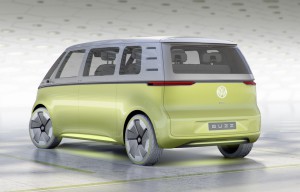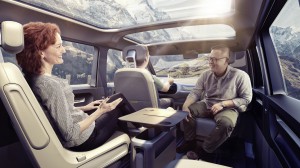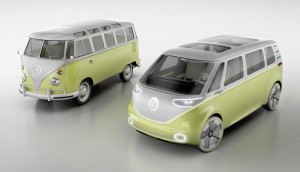
Everything that's old is new again with VW drawing inspiration for its new I.D. Buzz electric minivan from the Microbus.
Few automakers have been plugging into battery-electric propulsion like Volkswagen, the German automaker scaling back its traditional focus on diesels to launch as many as 30 different plug-based models by 2025.
As this year’s North American International Auto Show prepared to get underway, VW was building buzz with rumors that the list would include an all-new, version of its classic Microbus. Now, it’s taken the wraps off the concept vehicle it’s dubbed the Volkswagen I.D. Buzz.
“We are making electric mobility the new trademark of Volkswagen,” declared Herbert Diess, chairman of the Volkswagen brand. And though he wouldn’t say whether the I.D. Buzz will make the transition from concept to production, there are reasons to believe it very well could be in the works.
For one thing, VW has spent the last decade tinkering with various Microbus alternatives, including the well-received Bulli concept unveiled in 2011, as well as the battery-electric VW BUDD-e that was one of the automotive hits of the 2016 Consumer Electronics Show.
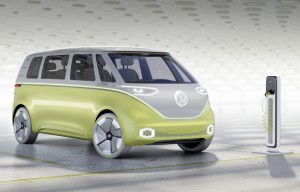
The Buzz borrows heavily from the exterior styling of the iconic Microbus, but the similarities end there.
The name, Buzz, is a play on the German pronunciation of the word, “bus,” VW explained, adding that it also refers to the sound of the show car’s twin electric motors, one for each axle.
As for the microbus show car, “The overall concept of the I.D. Buzz points the way to the future,” said Frank Welsch, the VW board member overseeing product planning. “This concept vehicle is the world’s first electric multi-purpose vehicle to be equipped with a fully autonomous driving mode. It carries the feeling of freedom of the Microbus over to a completely new era of mobility.”
Does that mean production plans are in the works? VW officials will only say that the Buzz is the follow-up to the initial I.D. concept shown at the Paris Motor Show a few months back. That VW Golf-sized hatchback pushed the idea of a long-range, mainstream electric vehicle a step further, the maker claiming that in production it could get as much as 375 miles per charge, or about 50% more than the new Chevrolet Bolt EV.
The VW I.D. Buzz measures 194.6 inches long, 77.8 inches wide and 77.3 inches tall, with a wheelbase of 129.9 inches. It rides on an extended version of the Modular Electric Drive Kit platform developed for the I.D. hatchback.
Both versions of the MEB platform, as the Germans call it, follow the layout that most new battery-electric vehicles are expected to take, placing the batteries under the load floor and the motors on the axles. That frees up much of the space normally devoted to the engine compartment. The result is what VW describes as “an extraordinarily spacious interior for its class.”
The approach also pays off in terms of vehicle dynamics by significantly lowering the center of gravity – a critical issue when you’re carrying a pack and ancillary climate control system that can approach a half-ton of mass.
The lithium-ion pack can produce 111 kilowatt-hours of energy, or about 10% more than the current power champ, the batteries in the Tesla Model S P100d. VW says that would yield about 600 kilometers – or 375 miles – per charge using the European test cycle, or 270 miles using the EPA test.
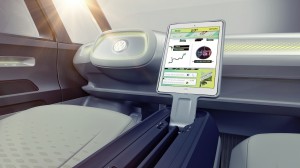
A simple push on the steering wheel and it folds in to the dashboard and makes the vehicle autonomous.
The batteries, meanwhile, could get an 80% “refill” in as little as 30 minutes using the advanced Combined Charging System. But it would take the better part of a day to recharge a completely drained battery using the conventional Level 2 chargers widely found in the U.S.
(Volkswagen spices up new Atlas with R-Line option. Click Here for the story.)
The battery pack powers two electric motors, one on each axle, each making 201 horsepower. The layout creates a virtual all-wheel-drive system. VW claims the concept vehicle debuting in Detroit could accelerate from 0 to 60 in about 5 seconds, with a governed top speed of 99 mph.
As with the VW BUDD-e concept shown at the 2016 CES, the new Volkswagen I.D. Buzz is loaded with an array of high-tech features, including the ability to drive autonomously.
“A slight push on the steering wheel makes it retract and merge into the instrument panel, switching the I.D. Buzz from manual control to the fully autonomous “I.D. Pilot” mode that could make it into production by 2025,” the maker said in a news release.
Once in “Pilot” mode, the Buzz is guided by a collection of onboard laser scanners and sensors, ultrasonic sensors, radar sensors, side area view cameras and a front camera. That data is integrated with traffic data that is acquired continuously. Autonomous mode ends when the driver touches the steering wheel or presses either the brake pedal or accelerator.
Using cloud-based data, the Buzz will recognize who is driving, automatically setting up various vehicle settings. The vehicle will automatically convert to that driver’s preferred climate control settings, radio stations, navigation system, exterior sounds and other preferences retrieved from the Cloud.
(Click Here for an update on VW’s diesel buyback settlement.)
Passengers can also operate the infotainment system, and input destinations, using a smartphone. The vehicle’s route can also be tracked using this set up.
While the Buzz does borrow heavily from the iconic Microbus that has been kicking around for decades, officials are quick to warn that it’s much more than a knock off from a bygone era.
“The I.D. BUZZ is not a retro design on 22-inch wheels,” said Klaus Bischoff, Volkswagen Head of Design, “rather, we have taken the logical next step forward in development using what is in all likelihood the most successful design of its kind in the world.
“The entire design is extremely clean with its homogeneous surfaces and monolithic silhouette. The future and origins of Volkswagen design DNA combine here to create a new icon.”
It retains the familiar and comfortable “V” on the front of the van that creates that pleasant “face” that is so quickly identifiable; however, VW shortened the classic overhangs found on earlier concepts attempting to bring back the Microbus. That does pose a challenge: meeting modern crash standards.
(To see more about VW readying to debut a new battery Microbus at NAIAS, Click Here.)
VW has been struggling to find a way to revive the iconic “hippie van” for several decades. Can it do that by stepping forward into the past? If nothing else, the launch of the I.D. Buzz, following last year’s BUDD-e, suggests the German automaker is serious about finding the right solution.

